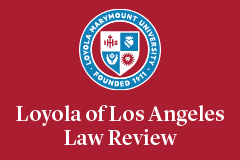Abstract
On June 28, 2012, the Supreme Court issued one of its most anticipated decisions in National Federation of Independent Business v. Sebelius (“NFIB”)—the constitutional challenge to the Patient Protection and Affordable Care Act (“ACA”). The ACA is President Obama’s signature accomplishment and creates a number of reforms intended to reduce cost, improve the quality of healthcare and health outcomes, and expand access to care. The main pillars of the ACA are the expansions of public and private insurance coverage. These expansions were the targets of a number of legal challenges by states, private individuals, and various organizations, with two reaching the Supreme Court in NFIB. The first, and the one that has received the most attention, was the challenge to the individual mandate as exceeding Congress’s commerce and taxing powers. The second was a challenge to the structure of the Medicaid expansion as coercive in violation of the Tenth Amendment limit on Congress’s spending power. These challenges were also significant because if either provision had been found unconstitutional, it might have been used to invalidate the entire heath reform law.
The political and legal commentary about the challenges focused on the mandate as an exercise of the commerce power. Opponents of reform warned that upholding the mandate would lead to an unprecedented expansion of federal power in violation of our dual system of government. They shaped the dominant narrative that presented federal power as an inherent threat to state sovereignty and individual liberty. The mandate was seen as the beginning of a parade of other horrible intrusions into our personal lives, and state opposition as essential to protecting personal liberty. In this narrative, NFIB presented the Court with a dichotomous choice: Would the conservative majority—Chief Justice Roberts, along with Justices Alito, Scalia, Thomas, and Kennedy—take this opportunity to further limit federal power, or could the liberal wing of the Court sway one of the other Justices (most wrongly predicted Justice Kennedy) to uphold the mandate? The Court surprised many by answering “yes” to both.
The Court upheld the mandate as a constitutional exercise of the taxing power and preserved the Medicaid expansion as an option for states, but Chief Justice Roberts’s approach defied the simplistic narrative that dominated commentary before the decision. By upholding the mandate and the ACA, the Court has preserved a powerful new version of cooperative federalism in healthcare—one that creates a federal platform for state experimentation, innovation, and regulation to facilitate meaningful choice in the private health-insurance market. At the same time, however, Chief Justice Roberts penned certain parts of the opinion that may advance more traditional federalist aims of limiting the commerce and spending powers. Most notable was the Court’s unprecedented finding that the Medicaid expansion was structured in a coercive way and so could not be required as a condition of Medicaid participation generally. States now have the choice to opt in to the expansion or to refuse to participate, creating uncertainty for the poorest residents in states that opposed reform. More fundamentally, this holding suggests that the Spending Clause may now be a more viable site for federalism-based attacks and used to limit the federal government’s ability to adapt its spending conditions to changing realities in longstanding healthcare programs like Medicaid and Medicare.
Recommended Citation
Brietta Clark,
Safeguarding Federalism by Saving Health Reform: Implications of National Federation of Independent Business v. Sebelius,
46 Loy. L.A. L. Rev. 541
(2013).
Available at: https://digitalcommons.lmu.edu/llr/vol46/iss2/24


